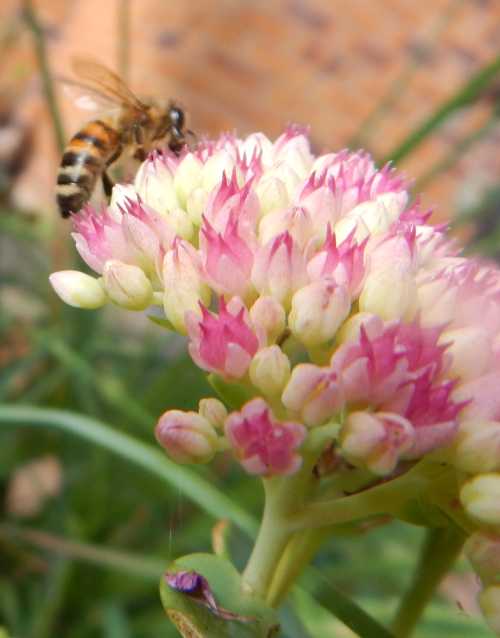Bee Venom
Updated: February 2025
Bee venom varies in composition depending on bee species,
and is a complex substance, containing pharmacologically active proteins, peptides and enzymes, and of course, venom.
Where Do Bees Produce Venom?
The sting of the honey bee is contained in a chamber at the end of the abdomen.
The sting consists of the sharp protruding sting itself (the
ovipositor), and a basal part where the venom is produced. The basal part contains the venom sac and glands
that produce the bee venom, along with muscles enabling the bee to
thrust the sting at a predator in the event of attack.
 Honey bee on Sedum.
Honey bee on Sedum.How much venom does a bee sting contain?
A single sting of a honey bee contains about 50 micrograms of venom.
Whilst this is
obviously sufficient to kill another insect predator, many multiples of
stings would usually be required to kill a human (except in cases of
severe
bee sting reactions).
Uses of bee venom
Although many people may fear being stung, and as a result may have a fear of bees (apiphobia),
bee venom therapy has actually been used to treat a variety of ailments
in the Far East and Eastern Europe, from rheumatic disease, and multiple
sclerosis to arthritis.
Indeed, beekeepers can take steps to avoid being stung, however, in the West, it is sometimes said that old beekeepers rarely suffer arthritis due to the stings they have received over the years! I believe there is research being conducted into its efficacy for the treatment of arthritis, and it will be interesting to read about the results.
In the meantime, if you are thinking about bee venom therapy, this does not mean you should find a bee hive, stand close to it, and hope the bees will sting you!
Bee venom in beauty products
More recently, venom is being collected from honey bees, and used in beauty treatments, from bee venom masks, to skin creams and beauty balms.
It is stated that
the venom fools the skin, causing blood to rush to the treated area,
and the skin to produce collagen and elastin. However, it has to be said there are already effective collagen skin treatments that can be taken orally or applied topically.
How Is Bee Venom Collected?
The 'ethical' method used to collect it, is via weak electric shock. Honey bees land on a pane of glass which emits the electrical current, causing the bee to sting the surface of the glass.
The honey bee ejects venom from their sting, but does not die because the sting remains in the bee's body. The fluid is then collected from the glass pane.
Whilst this is deemed ethical because the insects do not die, it must surely subject the bees to stress, thus causing them to sting. There is scientific evidence that bees have feelings, and exhibit stress responses.
Not surprisingly, bees certainly feel pain.
Allergy
It is important to seek the advice of a medical doctor if you are concerned about serious reactions if you are stung, or if the sting occurs in a sensitive area, such as in the nose or ear.
If you suffer from allergic reactions to bee stings, you should carry an Epipen with you at all times. Some reactions are, however, quite normal. To learn more, read about bee stings.
Do all bees sting?
If you found this page helpful or interesting, I'd really be grateful if you would share it with others - if not this page, perhaps another, such as Gardening For Bees.
Thank you so much :) .
